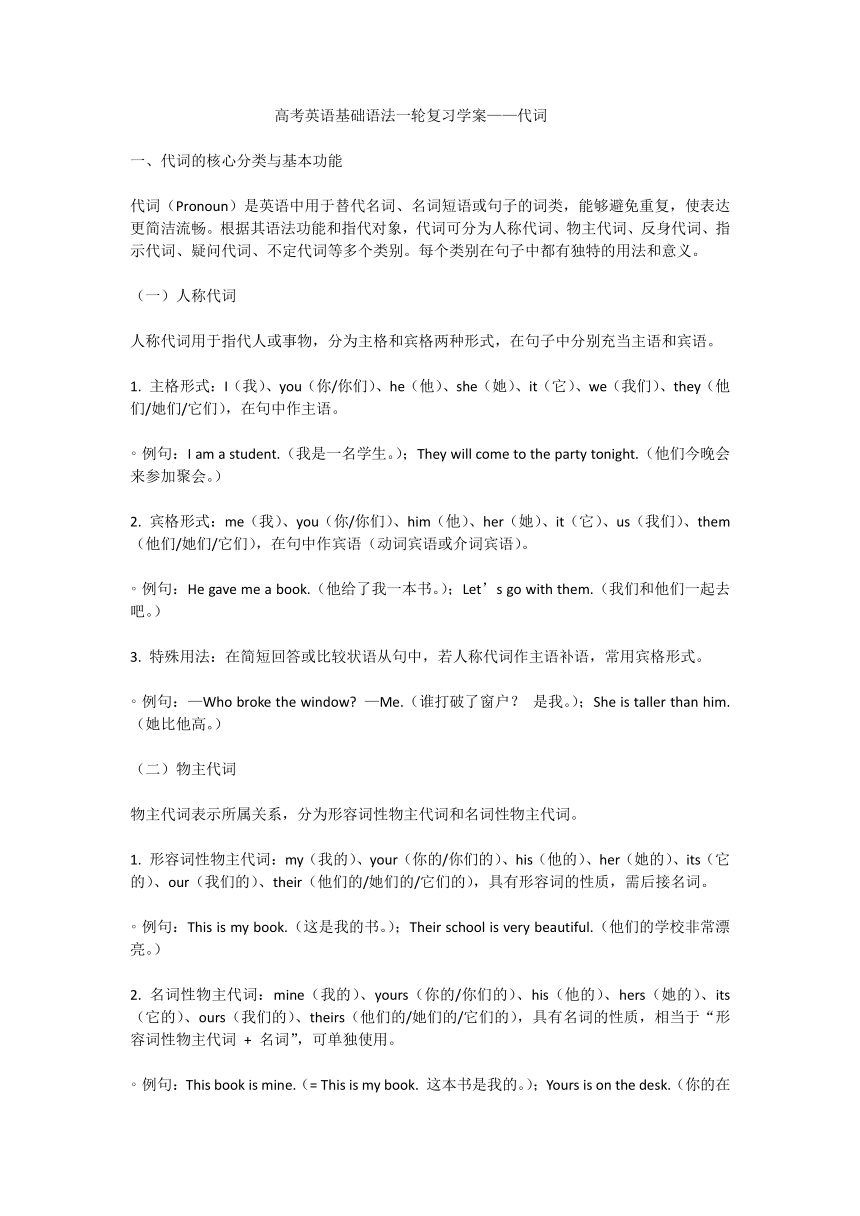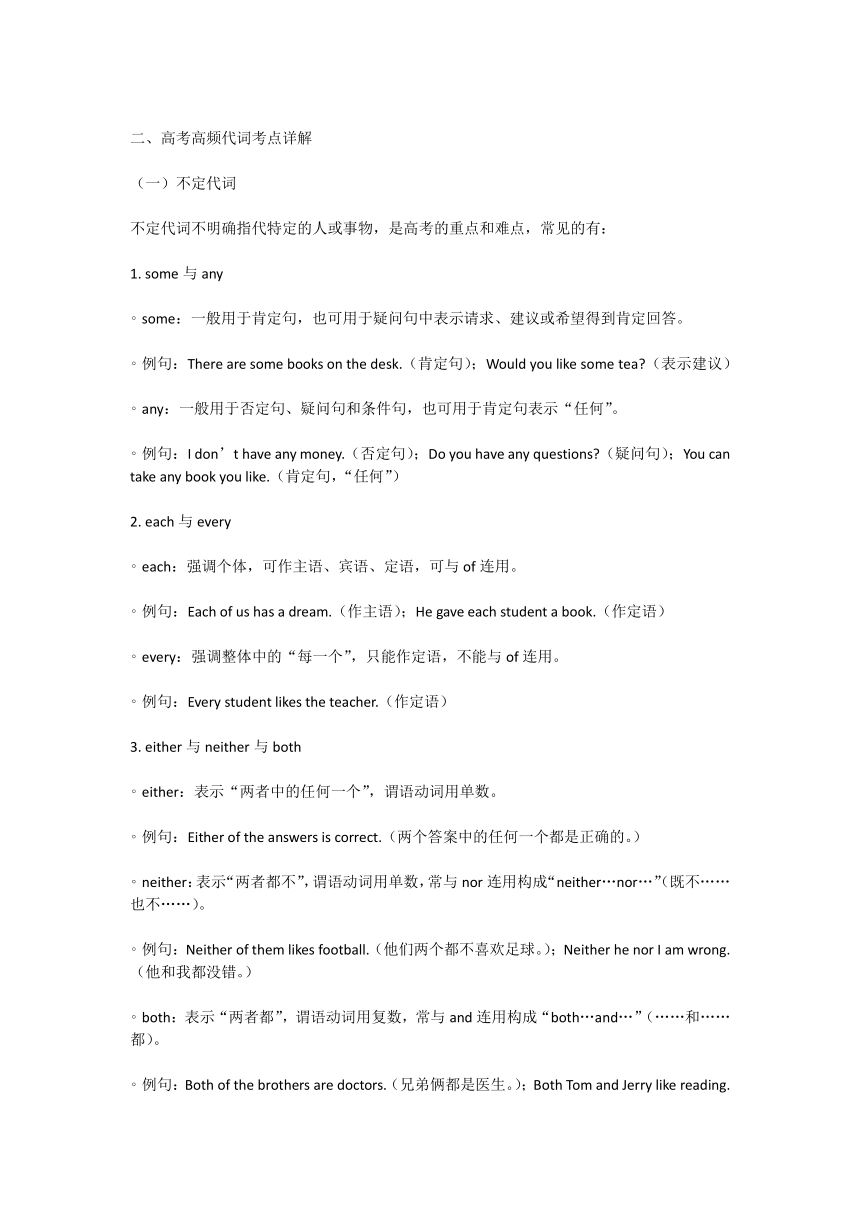高考英语基础语法复习(讲义)—代词
图片预览



文档简介
高考英语基础语法一轮复习学案——代词
一、代词的核心分类与基本功能
代词(Pronoun)是英语中用于替代名词、名词短语或句子的词类,能够避免重复,使表达更简洁流畅。根据其语法功能和指代对象,代词可分为人称代词、物主代词、反身代词、指示代词、疑问代词、不定代词等多个类别。每个类别在句子中都有独特的用法和意义。
(一)人称代词
人称代词用于指代人或事物,分为主格和宾格两种形式,在句子中分别充当主语和宾语。
1. 主格形式:I(我)、you(你/你们)、he(他)、she(她)、it(它)、we(我们)、they(他们/她们/它们),在句中作主语。
例句:I am a student.(我是一名学生。);They will come to the party tonight.(他们今晚会来参加聚会。)
2. 宾格形式:me(我)、you(你/你们)、him(他)、her(她)、it(它)、us(我们)、them(他们/她们/它们),在句中作宾语(动词宾语或介词宾语)。
例句:He gave me a book.(他给了我一本书。);Let’s go with them.(我们和他们一起去吧。)
3. 特殊用法:在简短回答或比较状语从句中,若人称代词作主语补语,常用宾格形式。
例句:—Who broke the window —Me.(谁打破了窗户? 是我。);She is taller than him.(她比他高。)
(二)物主代词
物主代词表示所属关系,分为形容词性物主代词和名词性物主代词。
1. 形容词性物主代词:my(我的)、your(你的/你们的)、his(他的)、her(她的)、its(它的)、our(我们的)、their(他们的/她们的/它们的),具有形容词的性质,需后接名词。
例句:This is my book.(这是我的书。);Their school is very beautiful.(他们的学校非常漂亮。)
2. 名词性物主代词:mine(我的)、yours(你的/你们的)、his(他的)、hers(她的)、its(它的)、ours(我们的)、theirs(他们的/她们的/它们的),具有名词的性质,相当于“形容词性物主代词 + 名词”,可单独使用。
例句:This book is mine.(= This is my book. 这本书是我的。);Yours is on the desk.(你的在桌子上。)
(三)反身代词
反身代词表示动作的执行者和承受者为同一人或事物,以-self(单数)或-selves(复数)结尾。
1. 常见形式:myself(我自己)、yourself(你自己)、himself(他自己)、herself(她自己)、itself(它自己)、ourselves(我们自己)、yourselves(你们自己)、themselves(他们自己/她们自己/它们自己)。
2. 用法:
作宾语:当主语和宾语为同一人或事物时使用。
例句:She taught herself English.(她自学英语。)
作同位语:用于强调主语或宾语,可位于其后或句末。
例句:The president himself attended the meeting.(总统亲自参加了会议。);You should do it by yourself.(你应该自己做这件事。)
常见短语:by oneself(独自地)、enjoy oneself(玩得开心)、help oneself to(随便吃/用)。
(四)指示代词
指示代词用于指代或修饰特定的人或事物,包括this(这个)、that(那个)、these(这些)、those(那些)、such(这样的)、same(相同的)。
1. 近指与远指:this/these指较近的人或事物;that/those指较远的人或事物。
例句:This is my pen, and that is yours.(这是我的笔,那是你的。);These books are mine, those are hers.(这些书是我的,那些是她的。)
2. 替代用法:that/those可指代上文提到的事物,以避免重复。
例句:The weather in Beijing is colder than that in Shanghai.(北京的天气比上海的冷。);The cars made in China are as good as those made in Japan.(中国制造的汽车和日本制造的一样好。)
3. such和same:such表示“这样的”,可修饰名词;same表示“相同的”,前需加定冠词the。
例句:Such a mistake should never be made again.(这样的错误不应再犯。);We are in the same class.(我们在同一个班级。)
二、高考高频代词考点详解
(一)不定代词
不定代词不明确指代特定的人或事物,是高考的重点和难点,常见的有:
1. some与any
some:一般用于肯定句,也可用于疑问句中表示请求、建议或希望得到肯定回答。
例句:There are some books on the desk.(肯定句);Would you like some tea (表示建议)
any:一般用于否定句、疑问句和条件句,也可用于肯定句表示“任何”。
例句:I don’t have any money.(否定句);Do you have any questions (疑问句);You can take any book you like.(肯定句,“任何”)
2. each与every
each:强调个体,可作主语、宾语、定语,可与of连用。
例句:Each of us has a dream.(作主语);He gave each student a book.(作定语)
every:强调整体中的“每一个”,只能作定语,不能与of连用。
例句:Every student likes the teacher.(作定语)
3. either与neither与both
either:表示“两者中的任何一个”,谓语动词用单数。
例句:Either of the answers is correct.(两个答案中的任何一个都是正确的。)
neither:表示“两者都不”,谓语动词用单数,常与nor连用构成“neither…nor…”(既不……也不……)。
例句:Neither of them likes football.(他们两个都不喜欢足球。);Neither he nor I am wrong.(他和我都没错。)
both:表示“两者都”,谓语动词用复数,常与and连用构成“both…and…”(……和……都)。
例句:Both of the brothers are doctors.(兄弟俩都是医生。);Both Tom and Jerry like reading.(汤姆和杰瑞都喜欢阅读。)
4. all与none
all:表示“三者或三者以上都”,作主语时,若指人,谓语动词用复数;若指物,谓语动词用单数。
例句:All of the students are here.(指人,复数);All of the food tastes good.(指物,单数)
none:表示“三者或三者以上都不”,可与of连用,谓语动词单复数均可。
例句:None of them has/have been to Beijing.(他们中没有人去过北京。)
5. other与another与the other
other:表示“其他的”,后接可数名词复数,也可与the连用特指“其余的”。
例句:There are other ways to solve the problem.(其他的方法);Some students like math, while the other students like English.(其余的学生)
another:表示“三者或三者以上中的另一个”,后接可数名词单数,也可用于“another + 数词 + 可数名词复数”结构。
例句:I don’t like this one. Please show me another.(另一个);We need another three chairs.(另外三把椅子)
the other:表示“两者中的另一个”,常用于“one…the other…”结构。
例句:I have two books. One is a novel, and the other is a textbook.(一本……另一本……)
(二)it的特殊用法
1. 作形式主语或形式宾语:当动词不定式、动名词或从句作主语或宾语时,为避免句子头重脚轻,常用it作形式主语或形式宾语,真正的主语或宾语后置。
作形式主语:It + be + 形容词/名词 + (for/of sb.) + to do sth.;It + be + 形容词 + that从句。
例句:It is important to learn English well.(= To learn English well is important.);It is said that he will come back next week.
作形式宾语:主语 + 谓语 + it + 形容词/名词 + 动词不定式/动名词/从句。
例句:I find it difficult to solve the problem.(= I find to solve the problem difficult.);We think it no use arguing with him.
2. 指代时间、距离、天气等:it可用于指代时间、距离、自然现象(如天气)等。
例句:It is 8 o’clock now.(时间);It is 10 kilometers from here to the station.(距离);It is raining heavily.(天气)
3. 用于强调句:强调句结构为“It is/was + 被强调部分 + that/who + 其他部分”。
例句:It was Tom who broke the window.(强调主语Tom);It is in the park that we met yesterday.(强调地点状语in the park)
(三)疑问代词
疑问代词用于构成特殊疑问句,包括who(谁,主格)、whom(谁,宾格)、whose(谁的)、what(什么)、which(哪一个/些)。
1. who与whom:who作主语或表语;whom作宾语,但在口语中常用who代替whom。
例句:Who is singing over there (作主语);Whom did you meet yesterday (作宾语,口语中常用Who)
2. what与which:what无范围限制,意为“什么”;which有范围限制,意为“哪一个/些”。
例句:What do you want to eat (无范围);Which book do you like, the red one or the blue one (有范围)
三、高考真题中的代词考点剖析
1. (2023全国甲卷)
题目:Some people think that we should protect ______ animals in danger, while others believe we should focus on ______ species that can benefit humans directly.
答案:all; some
解析:第一空表示“所有处于危险中的动物”,用all;第二空表示“一些能直接使人类受益的物种”,用some。
2. (2022新高考Ⅰ卷)
题目:If you have any questions, please feel free to ask ______.
答案:me/us
解析:ask后接宾语,根据语境可填me或us,表示“问我”或“问我们”。
3. (2021全国乙卷)
题目:The two shirts both look nice on me. I can’t decide which ______ to choose.
答案:one
解析:表示“两者中的一个”,用one指代shirt。
4. (2020全国Ⅲ卷)
题目:______ is known to all that China has made great progress in science and technology.
答案:It
解析:It作形式主语,真正的主语是that引导的从句。
四、代词易错点总结与复习建议
(一)易错点总结
1. 物主代词误用:混淆形容词性物主代词和名词性物主代词的用法,如误将“This book is my.”写成正确的“This book is mine.”。
2. 不定代词辨析错误:不能准确区分each与every、either与neither、other与another等的用法差异。
3. it的用法混淆:不清楚it作形式主语、形式宾语和在强调句中的不同用法。
(二)复习建议
1. 对比记忆法:制作表格或思维导图对比易混代词的用法(如不定代词的辨析),通过例句加深理解。
2. 语境练习法:多做高考真题和模拟题,在具体语境中体会代词的用法,总结规律。
3. 写作应用法:在日常写作中刻意使用不同类型的代词,提高运用的准确性和熟练度。
4. 易错点整理:建立错题本,将代词相关的错题分类整理,定期复习,强化薄弱环节。
通过系统梳理代词的各类考点,结合高考真题进行针对性训练,能够有效掌握代词的用法,为英语语法学习和综合能力提升奠定坚实基础。
一、代词的核心分类与基本功能
代词(Pronoun)是英语中用于替代名词、名词短语或句子的词类,能够避免重复,使表达更简洁流畅。根据其语法功能和指代对象,代词可分为人称代词、物主代词、反身代词、指示代词、疑问代词、不定代词等多个类别。每个类别在句子中都有独特的用法和意义。
(一)人称代词
人称代词用于指代人或事物,分为主格和宾格两种形式,在句子中分别充当主语和宾语。
1. 主格形式:I(我)、you(你/你们)、he(他)、she(她)、it(它)、we(我们)、they(他们/她们/它们),在句中作主语。
例句:I am a student.(我是一名学生。);They will come to the party tonight.(他们今晚会来参加聚会。)
2. 宾格形式:me(我)、you(你/你们)、him(他)、her(她)、it(它)、us(我们)、them(他们/她们/它们),在句中作宾语(动词宾语或介词宾语)。
例句:He gave me a book.(他给了我一本书。);Let’s go with them.(我们和他们一起去吧。)
3. 特殊用法:在简短回答或比较状语从句中,若人称代词作主语补语,常用宾格形式。
例句:—Who broke the window —Me.(谁打破了窗户? 是我。);She is taller than him.(她比他高。)
(二)物主代词
物主代词表示所属关系,分为形容词性物主代词和名词性物主代词。
1. 形容词性物主代词:my(我的)、your(你的/你们的)、his(他的)、her(她的)、its(它的)、our(我们的)、their(他们的/她们的/它们的),具有形容词的性质,需后接名词。
例句:This is my book.(这是我的书。);Their school is very beautiful.(他们的学校非常漂亮。)
2. 名词性物主代词:mine(我的)、yours(你的/你们的)、his(他的)、hers(她的)、its(它的)、ours(我们的)、theirs(他们的/她们的/它们的),具有名词的性质,相当于“形容词性物主代词 + 名词”,可单独使用。
例句:This book is mine.(= This is my book. 这本书是我的。);Yours is on the desk.(你的在桌子上。)
(三)反身代词
反身代词表示动作的执行者和承受者为同一人或事物,以-self(单数)或-selves(复数)结尾。
1. 常见形式:myself(我自己)、yourself(你自己)、himself(他自己)、herself(她自己)、itself(它自己)、ourselves(我们自己)、yourselves(你们自己)、themselves(他们自己/她们自己/它们自己)。
2. 用法:
作宾语:当主语和宾语为同一人或事物时使用。
例句:She taught herself English.(她自学英语。)
作同位语:用于强调主语或宾语,可位于其后或句末。
例句:The president himself attended the meeting.(总统亲自参加了会议。);You should do it by yourself.(你应该自己做这件事。)
常见短语:by oneself(独自地)、enjoy oneself(玩得开心)、help oneself to(随便吃/用)。
(四)指示代词
指示代词用于指代或修饰特定的人或事物,包括this(这个)、that(那个)、these(这些)、those(那些)、such(这样的)、same(相同的)。
1. 近指与远指:this/these指较近的人或事物;that/those指较远的人或事物。
例句:This is my pen, and that is yours.(这是我的笔,那是你的。);These books are mine, those are hers.(这些书是我的,那些是她的。)
2. 替代用法:that/those可指代上文提到的事物,以避免重复。
例句:The weather in Beijing is colder than that in Shanghai.(北京的天气比上海的冷。);The cars made in China are as good as those made in Japan.(中国制造的汽车和日本制造的一样好。)
3. such和same:such表示“这样的”,可修饰名词;same表示“相同的”,前需加定冠词the。
例句:Such a mistake should never be made again.(这样的错误不应再犯。);We are in the same class.(我们在同一个班级。)
二、高考高频代词考点详解
(一)不定代词
不定代词不明确指代特定的人或事物,是高考的重点和难点,常见的有:
1. some与any
some:一般用于肯定句,也可用于疑问句中表示请求、建议或希望得到肯定回答。
例句:There are some books on the desk.(肯定句);Would you like some tea (表示建议)
any:一般用于否定句、疑问句和条件句,也可用于肯定句表示“任何”。
例句:I don’t have any money.(否定句);Do you have any questions (疑问句);You can take any book you like.(肯定句,“任何”)
2. each与every
each:强调个体,可作主语、宾语、定语,可与of连用。
例句:Each of us has a dream.(作主语);He gave each student a book.(作定语)
every:强调整体中的“每一个”,只能作定语,不能与of连用。
例句:Every student likes the teacher.(作定语)
3. either与neither与both
either:表示“两者中的任何一个”,谓语动词用单数。
例句:Either of the answers is correct.(两个答案中的任何一个都是正确的。)
neither:表示“两者都不”,谓语动词用单数,常与nor连用构成“neither…nor…”(既不……也不……)。
例句:Neither of them likes football.(他们两个都不喜欢足球。);Neither he nor I am wrong.(他和我都没错。)
both:表示“两者都”,谓语动词用复数,常与and连用构成“both…and…”(……和……都)。
例句:Both of the brothers are doctors.(兄弟俩都是医生。);Both Tom and Jerry like reading.(汤姆和杰瑞都喜欢阅读。)
4. all与none
all:表示“三者或三者以上都”,作主语时,若指人,谓语动词用复数;若指物,谓语动词用单数。
例句:All of the students are here.(指人,复数);All of the food tastes good.(指物,单数)
none:表示“三者或三者以上都不”,可与of连用,谓语动词单复数均可。
例句:None of them has/have been to Beijing.(他们中没有人去过北京。)
5. other与another与the other
other:表示“其他的”,后接可数名词复数,也可与the连用特指“其余的”。
例句:There are other ways to solve the problem.(其他的方法);Some students like math, while the other students like English.(其余的学生)
another:表示“三者或三者以上中的另一个”,后接可数名词单数,也可用于“another + 数词 + 可数名词复数”结构。
例句:I don’t like this one. Please show me another.(另一个);We need another three chairs.(另外三把椅子)
the other:表示“两者中的另一个”,常用于“one…the other…”结构。
例句:I have two books. One is a novel, and the other is a textbook.(一本……另一本……)
(二)it的特殊用法
1. 作形式主语或形式宾语:当动词不定式、动名词或从句作主语或宾语时,为避免句子头重脚轻,常用it作形式主语或形式宾语,真正的主语或宾语后置。
作形式主语:It + be + 形容词/名词 + (for/of sb.) + to do sth.;It + be + 形容词 + that从句。
例句:It is important to learn English well.(= To learn English well is important.);It is said that he will come back next week.
作形式宾语:主语 + 谓语 + it + 形容词/名词 + 动词不定式/动名词/从句。
例句:I find it difficult to solve the problem.(= I find to solve the problem difficult.);We think it no use arguing with him.
2. 指代时间、距离、天气等:it可用于指代时间、距离、自然现象(如天气)等。
例句:It is 8 o’clock now.(时间);It is 10 kilometers from here to the station.(距离);It is raining heavily.(天气)
3. 用于强调句:强调句结构为“It is/was + 被强调部分 + that/who + 其他部分”。
例句:It was Tom who broke the window.(强调主语Tom);It is in the park that we met yesterday.(强调地点状语in the park)
(三)疑问代词
疑问代词用于构成特殊疑问句,包括who(谁,主格)、whom(谁,宾格)、whose(谁的)、what(什么)、which(哪一个/些)。
1. who与whom:who作主语或表语;whom作宾语,但在口语中常用who代替whom。
例句:Who is singing over there (作主语);Whom did you meet yesterday (作宾语,口语中常用Who)
2. what与which:what无范围限制,意为“什么”;which有范围限制,意为“哪一个/些”。
例句:What do you want to eat (无范围);Which book do you like, the red one or the blue one (有范围)
三、高考真题中的代词考点剖析
1. (2023全国甲卷)
题目:Some people think that we should protect ______ animals in danger, while others believe we should focus on ______ species that can benefit humans directly.
答案:all; some
解析:第一空表示“所有处于危险中的动物”,用all;第二空表示“一些能直接使人类受益的物种”,用some。
2. (2022新高考Ⅰ卷)
题目:If you have any questions, please feel free to ask ______.
答案:me/us
解析:ask后接宾语,根据语境可填me或us,表示“问我”或“问我们”。
3. (2021全国乙卷)
题目:The two shirts both look nice on me. I can’t decide which ______ to choose.
答案:one
解析:表示“两者中的一个”,用one指代shirt。
4. (2020全国Ⅲ卷)
题目:______ is known to all that China has made great progress in science and technology.
答案:It
解析:It作形式主语,真正的主语是that引导的从句。
四、代词易错点总结与复习建议
(一)易错点总结
1. 物主代词误用:混淆形容词性物主代词和名词性物主代词的用法,如误将“This book is my.”写成正确的“This book is mine.”。
2. 不定代词辨析错误:不能准确区分each与every、either与neither、other与another等的用法差异。
3. it的用法混淆:不清楚it作形式主语、形式宾语和在强调句中的不同用法。
(二)复习建议
1. 对比记忆法:制作表格或思维导图对比易混代词的用法(如不定代词的辨析),通过例句加深理解。
2. 语境练习法:多做高考真题和模拟题,在具体语境中体会代词的用法,总结规律。
3. 写作应用法:在日常写作中刻意使用不同类型的代词,提高运用的准确性和熟练度。
4. 易错点整理:建立错题本,将代词相关的错题分类整理,定期复习,强化薄弱环节。
通过系统梳理代词的各类考点,结合高考真题进行针对性训练,能够有效掌握代词的用法,为英语语法学习和综合能力提升奠定坚实基础。
